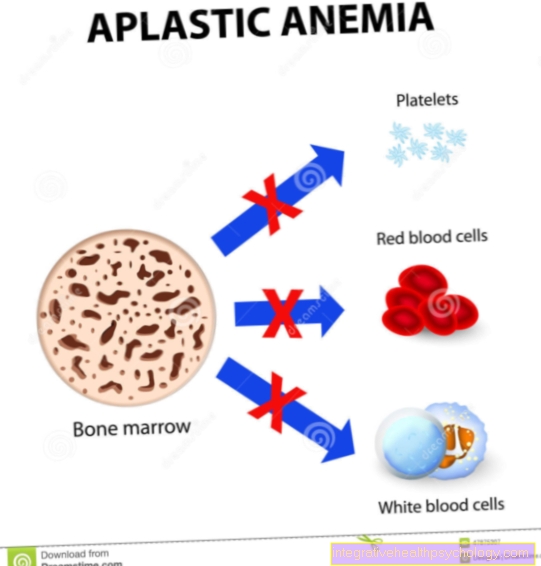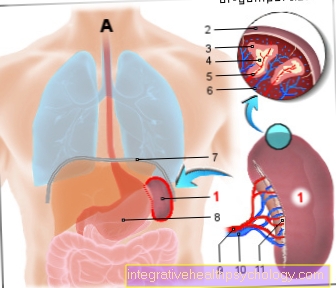Hodgkin lymphoma
definition
Under a Hodgkin lymphoma, also known as Hodgkin's disease, is a malignant disease of the lymphatic system in humans. By definition, these are certain cells of the immune system that B cells, degenerate and form malignant tumors emanating from the lymph nodes. In the classification of lymphomas, Hodgkin's lymphoma is one of the two large subgroups, the other group is made up of the manifold ones Non-Hodgkin lymphoma educated.

By definition, Hodgkin's lymphoma includes the presence of specific cells, the Sternberg-Reed giant cells and the eponymous Hodgkin cells. Hodgkin's lymphoma is characterized by swollen, externally palpable lymph nodes, as well as by the so-called B symptoms consisting of night sweats, weight loss and fever. Hodgkin's lymphoma can theoretically develop in any lymph node, but it often occurs in the neck or armpit or in the groin region.
Read more on the topic: Non-Hodgkin lymphoma
Compared to non-Hodgkin's lymphoma, Hodgkin's lymphoma has a relatively good prognosis, so that curative, i.e. healing-oriented therapy is always initiated. Hodgkin's lymphoma mostly affects young men between 25 and 30 years of age, with a second peak in incidence between 50 and 70 years of age.
Also read: The prognosis for a lymphoma
Cause of Hodgkin lymphoma
So far, it has not been possible to identify a clear cause of Hodgkin's lymphoma. However, some factors are known that are associated with Hodgkin lymphoma and so may be possible causes. Especially that Epstein-Barr Virus (EBV), the pathogen, etc. of Pfeiffer's glandular fever, is related to Hodgkin's lymphoma. In about 50% of the cases, EBV could be detected in this type of lymphoma. Likewise is the infection with HIV a risk factor for Hodgkin lymphoma, smoking is also discussed as a possible cause. In addition, Hodgkin's lymphoma can occur after aggressive, immunosuppressive therapy such as occur after organ transplantation.
Symptoms of Hodgkin Lymphoma
Hodgkin lymphoma causes a variety of symptoms that are more or less specific. As is very typical of Hodgkin lymphoma B symptoms The triad of symptoms of fever, unwanted weight loss (> 10% in the last 6 months) and pronounced night sweats. The patients then sweat so extremely that they have to change nightgowns and sheets. In addition, Hodgkin's lymphoma is usually associated with loss of appetite.
However, B symptoms can also e.g. occur in tuberculosis, other tumor diseases and inflammatory processes. Another characteristic of Hodgkin's lymphoma is persistent Swelling of lymph nodesthat can be felt as painless, firm knots under the skin of the neck, armpit or groin. The general symptoms of patients with Hodgkin's lymphoma are significant inefficiency and fatigue. Other rare but very specific symptoms are those that occur at intervals of 3-7 days Pel-Ebstein fever and, for unexplained reasons, pain in the affected lymph nodes after consuming alcohol (Alcohol pain). In the later stages, other symptoms are possible that result from involvement of other organs.
Read detailed information on: Pel-Ebstein fever
Symptoms of the skin in Hodgkin lymphoma

In addition to the symptoms described above, Hodgkin lymphoma in some cases also causes additional symptoms on the skin. In Hodgkin's lymphoma, for example, itching of the skin can develop, which occurs in a generalized manner and comes and goes at irregular intervals. The swelling of the lymph nodes is also visible on the skin if it is very pronounced. In addition, Hodgkin lymphoma can cause symptoms on the skin, known as paraneoplastic syndromes get ranked. This is the term used to describe symptoms that are not caused directly by the tumor, but by immune reactions and messenger substances "next to the tumor“ (paraneoplastic) occur.
In Hodgkin's lymphoma it can lead to Ichthyosis come, in which areas of the skin are noticeable through a thickened and cracked horny layer with flaking and itching. The skin must then be treated with ointments and horn-loosening substances. In addition to Hodgkin's lymphoma, symptoms of a Pemphigus vulgaris appear on the skin, which is a blistering skin condition that causes painful and easily bleeding erosions of the skin. These paraneoplastic syndromes are generally possible, but as rare symptoms they do not determine the clinical picture of Hodgkin's lymphoma.
Diagnosing Hodgkin's lymphoma
If a patient exhibits the above symptoms over a longer period of time, Hodgkin's lymphoma must be considered and the appropriate diagnosis initiated. The most important step is a lymph node biopsy (sampling) from an affected lymph node, after which the material is examined under a microscope. The Sternberg-Reed cells and Hodgkin cells typical of Hodgkin's lymphoma can then be detected here. This diagnosis must be carried out before starting therapy in order to confirm the diagnosis.
Read more on the subject at: Lymph node biopsy
But the subsequent staging examinations are no less important in order to classify the Hodgkin lymphoma correctly and to be able to choose the right therapy. In addition to a detailed clinical examination in which all lymph node stations are scanned as far as possible, a number of other diagnostics are used. Blood parameters such as signs of inflammation and cell counts are examined and the bone marrow may be punctured. Apparatus-based diagnostics are essential for Hodgkin's lymphoma.
An X-ray of the chest provides information about any infected lymph nodes in and on the lungs as well as in the so-called mediastinum, the space behind the breastbone between the lungs and heart. In Hodgkin's lymphoma, computed tomography of the neck and upper body is of great importance as it is the best way to classify the stages. A skeletal scintigraphy can also be useful to exclude bone involvement. Once the diagnosis has been confirmed and the final staging diagnosis has been carried out, Hodgkin's lymphoma is classified according to the Ann-Arbor classification.
Stages of Hodgkin's lymphoma
The stages in Hodgkin's lymphoma are classified according to Ann-Arbor, which is also used for non-Hodgkin's lymphomas. The decisive factor is the number and distribution of the affected lymph node stations in the body Diaphragm as an important and clinically relevant marker serves.
There are 4 stages in total:
I) Involvement of one (1) lymph node region or one (1) extranodal focus
II) Involvement of 2 or more lymph node regions or extranodal foci, where these are located exactly on one side of the diaphragm (above or below)
III) Involvement of 2 or more lymph node regions or extranodal foci, whereby these are located on both sides of the diaphragm (above and below)
IV) Disseminated, i.e. diffusely distributed involvement of one or more extralymphatic organs, whereby the lymph node status is no longer relevant here;
Affected regions are referred to as extranodal foci, in which the cells and thus the tumor have left the lymph nodes and spread to other tissue. Extralymphatic organs are all organs except the lymph nodes, the spleen and the thymus. In addition, additional designations are given, e.g. with A or B for the presence (B) or non-presence (A) of B symptoms. Based on these stages, the prognosis and treatment options can be roughly derived.
Therapy of Hodgkin's lymphoma
Therapy for Hodgkin's lymphoma is always aimed at healing, regardless of the stages, but the way is determined by the stages. Basically, there are two pillars of therapy for Hodgkin lymphoma: one intensive one chemotherapy by using effective, but also side-effect drugs on the one hand, as well as the radiotherapy on the other hand. The purpose of both methods is to destroy the degenerated cells and thus heal the tumor and thus the disease.
In stages 1 and 2, because of the more localized swelling of the lymph nodes, the focus is on radiation therapy, which is accompanied by chemotherapy, while chemotherapy plays the main role in stages 3 or 4. This is generally administered using defined therapy schemes. These are widespread in Hodgkin's lymphoma ABVD scheme (with the substances Adriamycin, bleomycin, vinblastine and dacarbazine) as well as that BEACOPP scheme (consisting of bleomycin, etoposide, adriamycin, cyclophosphamide, oncovin, procarbazine and Prednisone). These substances are given in several cycles over weeks at fixed doses and intervals depending on the stage and cause the tumor cells to die out or to be inhibited.
However, this therapy is rich in side effects such as nausea, vomiting, and hair loss. Radiation can be used in a more targeted manner and uses high-energy rays to destroy Hodgkin's lymphoma without damaging much healthy tissue. However, the risk of second malignancies is always increased after therapy. The exact treatment for Hodgkin's lymphoma is complicated and always has to be weighed up on an individual basis, as other risk factors and circumstances that the patient brings with him also influence the decision.
Also read: Lymphoma therapy
Prognosis of Hodgkin's lymphoma
Although the term Hodgkin lymphoma is mostly used negatively in the population, the prognosis for Hodgkin lymphoma is better than expected. After the initiation of therapy, some side effects initially occur that severely impair the quality of life for the duration of the therapy, but these can be alleviated with supportive measures. Overall, after adequate therapy, Hodgkin's lymphoma has one compared to most other cancers very good prognosis, especially in childhood. 5 years after the end of the therapy, 80-90% of the patients are still alive, in children more than 90%. The likelihood of recurrence can be reduced with relapse therapy, thus further improving the prognosis. However, it must be said that the lifelong risk of further tumors is increased.
Also read: The prognosis for a lymphoma
Life expectancy with Hodgkin lymphoma
The life expectancy of a patient with Hodgkin lymphoma depends on a quick diagnosis and good therapy. If left untreated, life expectancy after diagnosis is an average of 1.5 years, which, however, has been greatly increased by the latest therapy methods. If the disease is cured, a normal life expectancy can be assumed. Statistically, a healed Hodgkin patient has an almost normal life expectancy, which is only affected by the risk of second malignancies.





























